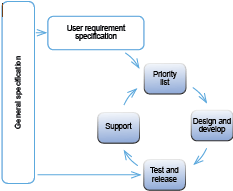

Various pitfalls and challenges mark the road to designing and implementing MES (manufacturing execution systems), MIS (manufacturing information systems) and MOM (manufacturing operations management) systems successfully and cost-effectively. Some of these challenges include the following:
1. MOM/MES systems are complex systems which can impact negatively on a manufacturing operation’s production capability during the implementation phase due to operator and user learning curves.
2. System integrators need to fully understand the often intricate business processes found on the plant floor and in the manufacturing facility.
3. Integration from sensor to ERP level involves transforming data from the millisecond dimension to an hourly, shift or daily aggregate dimension.
4. Clients need to come to terms with international standards such as ISA 95 and ISA 88.
5. Modern software offers feature-rich, advanced functionality and new benefits for the business could be discovered as the project unfolds. This can affect scope and cost and requires flexibility in terms of the implementation methodology.
As a result of the above issues, MOM/MES system development always had long time-lines, huge costs and risks. Due to these risks and costs, strict Software Development Life Cycle (SDLC) processes were implemented.
Traditional SDLC
The formal SDLC of General Specification, User Requirement Specification (URS), Functional Requirements Specification (FRS), Detailed Design Specification (DDS), System Build, Testing, Implementation and Maintenance were typically followed and the first phases before client testing spanned several months (if not years). Some of the disadvantages of following the formal SDLC include:
1. Users must wait until the end of the project before tangible results are seen. This makes change management and user acceptance difficult.
2. Change requirements negatively impact cost and delivery time-lines.
3. The business processes and requirements may change, between the time the design is approved and the time by which the solution is fully developed.
Figure 1 depicts the traditional software development life cycle.

Agile software development
Agile software development is another methodology well suited for MOM, MES and MIS system design and implementation. According to Agile methodology, software is developed and implemented in small sprints, or increments.
This allows several opportunities to evaluate and change the project during its lifecycle, as well as keeping the end user informed and involved in development. Some of the benefits, as applied to MES and MIS projects, include:
1. Teamwork and synergy between users and developers.
2. Customer satisfaction, through rapid delivery of useful software.
3. Working software is delivered frequently, ie, weeks rather than months.
4. Regular adaptation to changing circumstances is enabled.
5. Changing requirements are welcomed.
6. Implementation risk is reduced by allowing it to be performed in small increments.
SCRUM methodology is an extensive Agile software methodology that can be followed whilst developing and implementing software. Numerous companies offer assistance in managing SCRUM methodology and provide appropriate training. Information on the methodology is also readily available on the Internet.
Even the latest Good Automated Manufacturing Practices (GAMP) guidebook, developed for and by the highly-regulated and controlled pharmaceutical industry, acknowledges the need for methodologies other than the traditional (Waterfall) SDLC approach. GAMP acknowledges that an iterative approach can also be applied in a controlled manner. Agile is thus an accepted alternative to the traditional approach, even in regulated industries.
Non standard Agile
Another option is to use a non-standard Agile approach, which consists of initially executing only the first two phases of the traditional SDLC: General Specifications and URS. These two phases can also be seen as the planning and analysis phases of the project. After the URS phase, requirements are prioritised, based on user preferences and quick wins. Then the highest priority requirement is developed, tested and implemented, followed by the next and so on. The URS phase is limited to high level detail, while finer details are not specified until the design/development phase. The advantages of this approach are:
1. It allows for a formal planning and analysis phase, coupled with a flexible development and implementation phase.
2. The general and URS phases define the scope, requirements and time-lines of the project.
3. Should an important new requirement be identified during the development, it can easily be substituted with another initial requirement that has a similar effort-level.
Furthermore, this non-standard Agile approach includes the various benefits mentioned under standard Agile. Figure 2 shows non-standard Agile methodology.

Prototyping
Prototyping (or piloting) is another methodology that can be used successfully with MOM, MES and MIS systems projects. Prototyping as applied to MES and MIS systems is taking a slice (of the larger requirement) and implementing a small working system within a short time, usually on one section of a plant. Prototyping has the following advantages:
1. The cost of implementing a prototype is small, compared to the cost of a final system.
2. The prototype hardware requirements are much lower than the requirements for a final system, and existing hardware can often be used, thus obviating the need for expensive hardware.
3. System software can often be used for a trial period, ie, without having to purchase software.
4. Results are quickly realised, which allows a client to use and experience the system and gain a sense of the final solution as well as the benefits the system can deliver.
5. Prototypes can be used as a means of communication between system integrators and clients: to help system integrators understand client requirements and to help clients understand the business benefits of the system technology.
6. The lessons learnt during prototyping can be said to be the biggest advantage.
MESA had, traditionally, subscribed to GAMP’s methodology. Since the introduction of GAMP Version 5, which opened the door for other methodologies, MESA has recommended that companies explore alternatives on account of their clear benefits. MESA advocates prototyping in a number of White Papers and has incorporated prototyping into the MESA Global Education Program.
MESA does, however, recommend that such alternatives be explored within a Standards framework as part of a larger manufacturing transformation strategy. This is required, since the alternative could well prove to be several small, incompatible functional solutions, developed in parallel with disregard for future integration requirements.
Conclusion
Vast benefits, for both system integrator and client, can be realised by first piloting a project or following a non-standard Agile approach. The Agile approach is a specifically useful alternative if the client is risk adverse or has funding resource limitations. Securing project go-ahead and approval is eased by using the Agile or Prototype approach as the financial risks are mitigated and deliverables can be quantified in small chunks.
Finally, before the start of the project, it is imperative for system integrators and clients to agree on which methodology to follow. This ensures that expectations of integrator and client align from the start. In using this method, the onus lies on the project delivery system (the system integrator and business users) to produce and maintain the necessary project confidence to enable continuity of the project.
For more information contact Nees van der Walt, Bytes Systems Integration, +27 (0)11 205 7000, [email protected], www.bytessi.co.za

© Technews Publishing (Pty) Ltd | All Rights Reserved